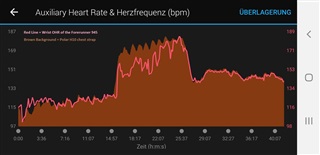Now the DataField “Auxiliary Heart Rate” is available in the Forerunner 945 Garmin Connect Store.
The data field write in the fit file. “Heart Rate” contain the OHR and “Auxiliary Heart Rate” the chest strap. For all the statistics from an activity like Training Effect, Training Load, Training Focus, Recovery Time, … I would prefer the opposite but this seems to be not possible for the developer.
After opening the activity in Garmin Connect I can do now an overlap of “Heart Rate” and “Auxiliary Heart Rate”.
Especially for cycling it looks very bad for me. That was already clear for me, but now I have the real data.
Now I can also try to improve how I wear my watch to get less differences. Any hints?
What is your experience? Can I trust at minimum the resting heart rate I get in the morning, or is even this OHR value wrong?



